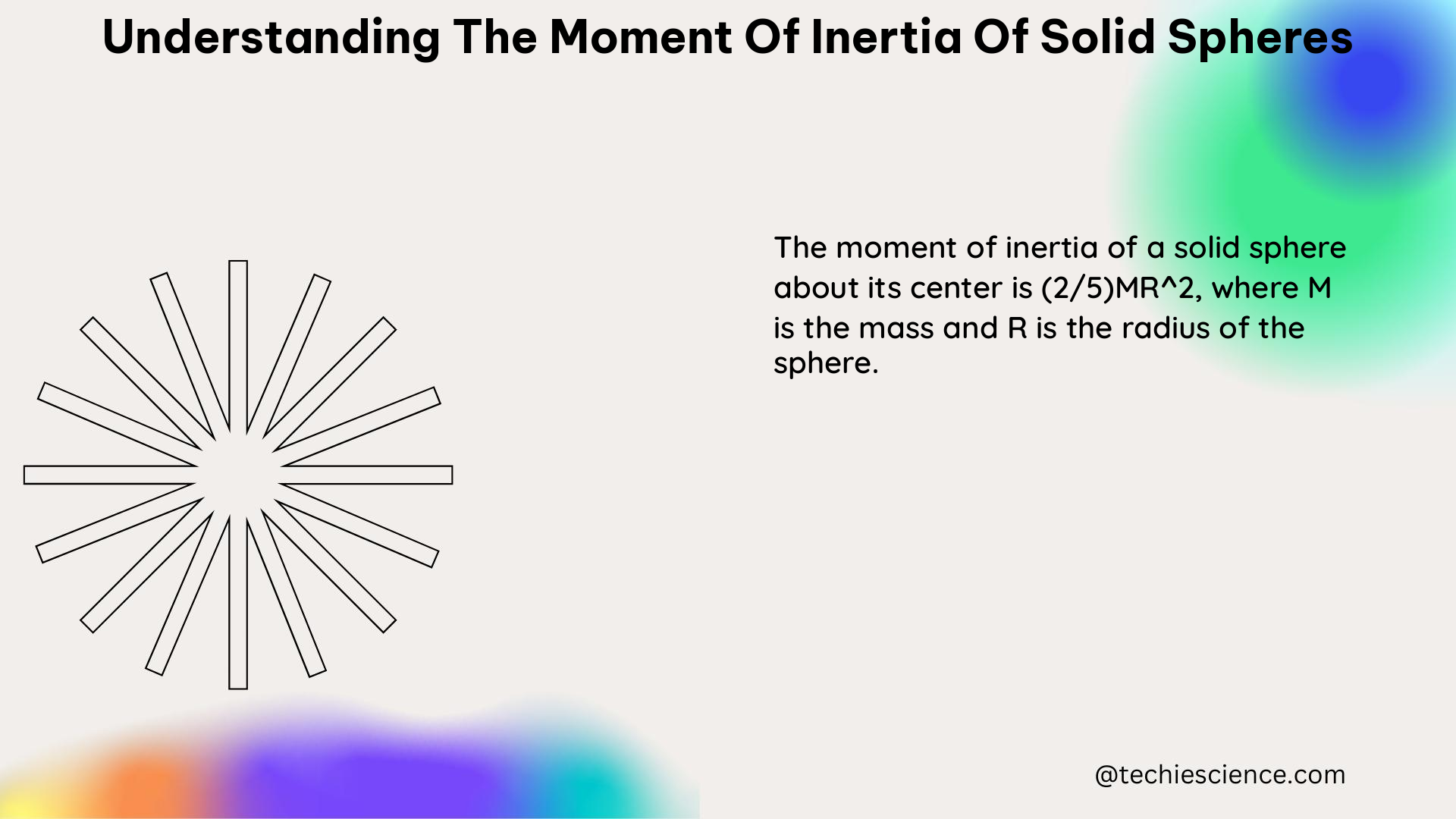The moment of inertia of a solid sphere is a crucial concept in classical mechanics, as it describes the resistance of a sphere to changes in its rotational motion. This comprehensive guide will delve into the key formulas, derivations, technical specifications, and practical applications of understanding the moment of inertia of solid spheres.
Key Concepts and Formulas
Moment of Inertia (I)
The moment of inertia of a solid sphere is given by the formula:
$$I = \frac{2}{5}mr^2$$
where $m$ is the mass of the sphere and $r$ is its radius.
Derivation of the Moment of Inertia Formula
The moment of inertia of a solid sphere can be derived by integrating the moments of infinitesimally thin disks from the top to the bottom of the sphere. This involves the following steps:
- Divide the sphere into thin disks of thickness $dz$.
- Calculate the moment of inertia of each disk about its own axis.
- Integrate the moments of all the disks from the top ($z = r$) to the bottom ($z = -r$) of the sphere.
The resulting integral leads to the formula $I = \frac{2}{5}mr^2$.
Physical Significance of Moment of Inertia
The moment of inertia is a measure of the resistance of a body against a change in its rotational motion. It depends on the distribution of the mass relative to the axis of rotation. A higher moment of inertia means the body is more resistant to changes in its rotational motion.
Technical Specifications and Measurements

Relationship between Moment of Inertia, Mass, and Radius
The moment of inertia of a solid sphere is directly proportional to its mass and the square of its radius. This means that increasing the mass or the radius of the sphere will result in a higher moment of inertia.
Comparison with Hollow Spheres
Hollow spheres have a greater moment of inertia than solid spheres of the same mass and radius. This is because the mass of a hollow sphere is distributed farther from the axis of rotation, resulting in a higher resistance to changes in rotational motion.
The moment of inertia formula for a hollow sphere is:
$$I = \frac{2}{3}mr^2$$
where $m$ is the mass of the sphere and $r$ is its radius.
Experimental Methods
There are two main experimental methods to determine the moment of inertia of a solid sphere:
-
Torsion Oscillation Method: Measure the period of oscillation of a torsion axle with the sphere attached. The moment of inertia can be calculated from the period of oscillation.
-
Rotational Velocity Comparison: Compare the angular velocity of a solid sphere and a hollow sphere of the same mass and radius when rotated about the vertical axis. The sphere with the higher moment of inertia will have a lower angular velocity.
Theoretical Explanation and Examples
Mathematical Derivation of the Moment of Inertia Formula
The moment of inertia of a solid sphere can be derived by summing the moments of infinitesimally thin disks from the top to the bottom of the sphere. This involves the following steps:
- Divide the sphere into thin disks of thickness $dz$.
- Calculate the moment of inertia of each disk about its own axis using the formula $dI = \rho \pi r^4 dz$, where $\rho$ is the density of the material.
- Integrate the moments of all the disks from the top ($z = r$) to the bottom ($z = -r$) of the sphere.
The resulting integral leads to the formula $I = \frac{2}{5}mr^2$.
Practical Applications of Moment of Inertia
Understanding the moment of inertia of solid spheres is crucial in various fields, such as:
- Engineering: Analyzing the behavior of rotating machinery, such as flywheels, gears, and turbines.
- Physics: Studying the dynamics of rotating objects, including the motion of planets, stars, and galaxies.
- Astronomy: Determining the mass distribution and rotational properties of celestial bodies.
- Sports: Analyzing the motion of sports equipment, such as balls and wheels, to optimize their performance.
Figures and Data Points
Moment of Inertia Formula
$$I = \frac{2}{5}mr^2$$
This formula shows the direct relationship between the moment of inertia, mass, and radius of a solid sphere.
Comparison of Moments of Inertia
- Solid sphere: $$I = \frac{2}{5}mr^2$$
- Hollow sphere: $$I = \frac{2}{3}mr^2$$
These formulas highlight the difference in moment of inertia between solid and hollow spheres of the same mass and radius.
References
- “Lab Exp 02.docx – Experiment Title: Determine the moment of inertia of solid cylinder and sphere.” (Course Hero)
- “Inertia of a Solid Sphere Formula Derivation” (YouTube)
- “Distinguishing between solid spheres and hollow spheres (equal mass)” (Physics Stack Exchange)
- “Moment of Inertia, Sphere” (HyperPhysics Concepts)
- “Moment Of Inertia Of A Sphere – Equations And Their Derivation” (Byju’s)

The lambdageeks.com Core SME Team is a group of experienced subject matter experts from diverse scientific and technical fields including Physics, Chemistry, Technology,Electronics & Electrical Engineering, Automotive, Mechanical Engineering. Our team collaborates to create high-quality, well-researched articles on a wide range of science and technology topics for the lambdageeks.com website.
All Our Senior SME are having more than 7 Years of experience in the respective fields . They are either Working Industry Professionals or assocaited With different Universities. Refer Our Authors Page to get to know About our Core SMEs.